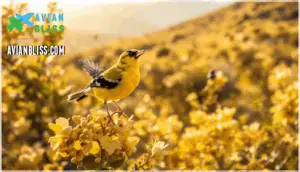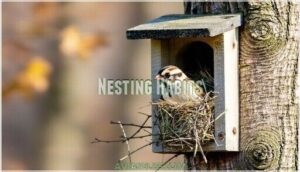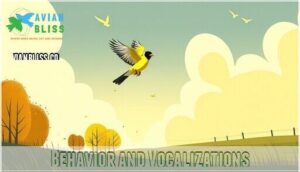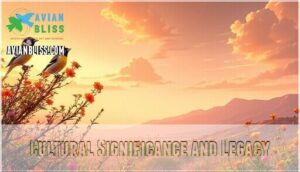This site is supported by our readers. We may earn a commission, at no cost to you, if you purchase through links.
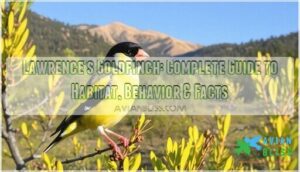 You’ll spot Lawrence’s goldfinch by its distinctive black face and brilliant yellow body – it’s California’s most unique goldfinch species.
You’ll spot Lawrence’s goldfinch by its distinctive black face and brilliant yellow body – it’s California’s most unique goldfinch species.
These 4.75-inch birds breed along California’s coast from Shasta County to Baja, preferring open woodlands and chaparral near water.
Unlike other goldfinches, they’re nomadic wanderers, following unpredictable migration routes based on seed crops and rainfall patterns.
Males sport that signature black forehead and throat with bright yellow underparts, while females show subtler grayish-brown tones with yellow belly hints.
They’re seed specialists, with fiddleneck being their breeding season favorite, and their stubby pink bills help crack tough seeds.
They’ll travel in flocks up to 700 birds when food’s abundant, and what makes their nesting strategy so unusual might surprise you.
Table Of Contents
- Key Takeaways
- Description of The Lawrence’s Goldfinch
- Habitat and Range
- Feeding Behavior
- Nesting Habits
- Behavior and Vocalizations
- Conservation Status and Threats
- Cultural Significance and Legacy
- Frequently Asked Questions (FAQs)
- What is the difference between a Lawrence goldfinch and an American Goldfinch?
- Who was Lawrence’s goldfinch named after?
- What is the Lawrence’s goldfinch habitat?
- What is the range of the Lawrence goldfinch?
- How can I attract Lawrences Goldfinches to my backyard?
- What is the lifespan of a Lawrences Goldfinch?
- Do Lawrences Goldfinches migrate long distances?
- How can I help conserve Lawrences Goldfinch populations?
- Are there any unique cultural depictions of the Lawrences Goldfinch?
- How long do Lawrences Goldfinches typically live?
- Conclusion
Key Takeaways
- You’ll identify Lawrence’s goldfinch by its distinctive black face and brilliant yellow body – it’s California’s most unique goldfinch species that measures 4.75 inches long.
- You’ll find these nomadic wanderers following unpredictable migration routes across California’s open woodlands and chaparral, moving based on seed crops and rainfall rather than fixed seasonal patterns.
- You’ll notice they’re seed specialists with a 95% plant-based diet, particularly favoring fiddleneck seeds during breeding season and traveling in flocks up to 700 birds when food’s abundant.
- You’ll see their conservation challenges despite "Least Concern" status – habitat loss from urban sprawl, climate change impacts, and water scarcity threaten their nomadic lifestyle across their limited 380,000 global population.
Description of The Lawrence’s Goldfinch
You’ll recognize Lawrence’s goldfinch by its striking appearance and unique markings that set it apart from other finches.
This compact bird measures about 4.75 inches long and weighs just 0.4 ounces.
The plumage details reveal fascinating sexual dimorphism—males sport bold black foreheads and throats contrasting with bright yellow underparts, while females display more subdued grayish-brown tones with subtle yellow belly washes.
Both sexes share identifying features like yellow wing edges, slightly forked tails, and distinctive yellow rumps visible during flight.
Their plumage brightening occurs after spring molts, making males particularly vibrant.
The pink-to-gray bills are stubbier than other goldfinches, creating easy size comparison markers.
Males showcase larger yellow patches and black caps, while females lack prominent black markings.
These plumage variations make field identification straightforward once you know what you’re looking for.
Habitat and Range
Lawrence’s goldfinch calls coastal California home, with its breeding range stretching from Shasta County south through the Coast Ranges and Sierra Nevada foothills into northern Baja California.
You’ll spot these nomadic birds in open woodlands, chaparral, and brushy areas that blend seamlessly with weedy fields near reliable water sources.
Their winter distribution shifts dramatically as flocks wander eastward into southern Arizona, southwestern New Mexico, and occasionally western Texas.
This migration pattern isn’t predictable like other songbirds – they’re opportunistic wanderers following seed crops and rainfall.
Climate change poses real challenges, altering traditional food sources and increasing habitat loss as oak woodlands convert to development.
During drought years, you’ll see range expansion toward the coast and upslope in the Sierras.
Wet years bring movement into the Central Valley.
These birds are classified as Least Concern by the IUCN.
These goldfinches need that perfect combo: dry country with brush, meadows, and accessible water within half a mile.
Feeding Behavior
How do these remarkable birds fuel their nomadic lifestyle? Lawrence’s Goldfinches have developed specialized feeding behavior that supports their unpredictable movements across western landscapes.
Their diet consists of approximately 95% plant matter, with seeds forming the foundation of their survival strategy.
Key Feeding Habits:
- Seed Preference: Fiddleneck seeds dominate during breeding season, while chamise and mistletoe berries sustain winter flocks
- Foraging Flocks: Mixed groups of up to 700 birds exploit seasonal food patches together
- Water Dependence: Frequent drinking visits to permanent sources due to their dry seed diet
- Seasonal Foods: Diet shifts from annual plant seeds in spring to perennial shrub seeds in fall
These agile feeders demonstrate remarkable flexibility, hanging upside-down from seedheads and methodically working through productive patches.
Their feeding habits directly influence migration patterns, as flocks follow rainfall and seeding cycles across diverse habitats from chaparral to desert washes.
To attract these birds, consider offering fresh Nyjer seeds.
Nesting Habits
You’ll find Lawrence’s Goldfinches build their nests with surprising flexibility, choosing locations that balance safety with access to water and food sources.
These birds construct their homes using a mix of fine plant materials, creating structures that can withstand the variable conditions of their arid western habitats.
Nest Placement
When choosing where to build, you’ll find Lawrence’s Goldfinch females favor drooping outer branches in trees and tall shrubs.
Site Selection focuses on Nest Height between 4-25 feet, providing ideal Camouflage Techniques within dense foliage.
They may even use specialized nest materials for added protection.
Nest Orientation typically faces away from prevailing winds.
Their nesting behavior prioritizes locations near water sources while avoiding exposed positions that attract predators.
Nest Description
During construction, female Lawrence’s Goldfinches weave Nest Materials like grass, leaves, and plant down into a compact cup.
These Nest Construction projects feature feather linings for comfort.
Nest Dimensions remain small yet sturdy, while natural Camouflage Techniques help blend the structure into surrounding foliage.
For supplemental options, consider pre-made nesting materials.
Each Nest Description reveals the species’ unique nesting behavior and architectural skills.
Nesting Facts
The female lays 3-6 white eggs during nesting season, with incubation period lasting 12-13 days.
Both parents handle fledgling care after young hatch.
Here’s what makes their nesting habits special:
- Nest construction uses fine grasses and plant fibers
- Colonial nesting sites can host multiple pairs nearby
- Brood size averages 4 eggs per clutch
- Nest materials include leaves woven into cup shapes
Young fledge at 11 days old, which is a key part of their nesting habits and overall brood size.
Behavior and Vocalizations
Lawrence’s Goldfinch behavior and vocalizations reveal fascinating social interactions and remarkable adaptability.
You’ll notice males performing elaborate threat displays during breeding season, lowering wings and fanning tails while singing directly at rivals.
Their flight patterns feature distinctive sinusoidal movements with rapid wingbeats followed by short glides.
These birds showcase exceptional song complexity, with males delivering long, melodious sequences of high-pitched notes and trills.
Their melodious trills create nature’s most complex finch symphony, weaving high-pitched notes into pure musical magic
What’s truly remarkable is their learning behavior – they’re outstanding vocal mimics, precisely copying calls from dozens of other species and even frogs.
This call variation helps with territory defense and mate attraction.
Outside breeding season, you’ll find them in gregarious flocks up to 700 birds, mixing with other finch species.
Their bird vocalizations include contact notes for group cohesion and sharp alarm calls when danger threatens.
These bird behavior patterns shift seasonally, from territorial aggression in spring to cooperative flocking during nomadic movements influenced by water and seed availability.
Conservation Status and Threats
Despite its "Least Concern" status, lawrences goldfinch faces real challenges that threaten its future.
With only 380,000 birds globally, this species walks a tightrope between stability and decline.
Habitat Loss from California’s urban sprawl tops the threat list, destroying the open woodlands these finches call home.
Climate Change impacts hit especially hard – altered rainfall patterns and rising temperatures disrupt their nomadic lifestyle, forcing birds to search farther for suitable conditions.
Water Scarcity becomes critical as drought intensifies across the Southwest, while Population Trends show concerning variability that’s difficult to track due to their unpredictable movements.
Pesticide Use and invasive plants further degrade their preferred habitats.
The conservation status reflects a species caught between survival and vulnerability, requiring active bird conservation efforts to maintain healthy populations in an increasingly challenging landscape.
Cultural Significance and Legacy
Beyond its ecological role, Lawrence’s Goldfinch carries deep cultural significance across Western communities. This charming bird has woven itself into the fabric of California’s identity, appearing in regional art, literature, and folklore for over a century.
A golden thread woven through California’s wild tapestry, carrying stories in every flight
In Western art, the species symbolizes joy and nature’s fleeting beauty. California poets have celebrated these goldfinches as emblems of the state’s unique wildlife heritage. Ornithological illustrations from the 1800s showcase the bird alongside native wildflowers, while its delicate coloration serves as a metaphor for understated elegance.
Local folklore enriches the bird’s cultural legacy. Central Valley oral histories describe Lawrence’s Goldfinch as a luck-bringer during migration seasons. Indigenous Chumash and Ohlone narratives feature the species as gentle messengers, while traditional songs link their distinctive calls to seasonal changes.
- Appears in California poetry as a state wildlife symbol
- Featured in museum exhibitions focused on avian iconography
- Inspires educational programs in state parks and nature centers
- Names multiple birdwatching clubs and citizen science projects
- Represents successful wildlife coexistence in conservation campaigns
Frequently Asked Questions (FAQs)
What is the difference between a Lawrence goldfinch and an American Goldfinch?
You’ll spot key differences between these goldfinches: Lawrence’s has gray plumage with yellow patches and a black face on males.
While American Goldfinches show bright yellow bodies with black wings and caps during breeding season.
Who was Lawrence’s goldfinch named after?
You’ll discover this bird honors George Newberry Lawrence, a 19th-century American ornithologist and businessman who collected and described numerous North American bird species during the 1800s.
What is the Lawrence’s goldfinch habitat?
Like a nomad following rain across the desert, you’ll find Lawrence’s goldfinches roaming California’s open woodlands, chaparral, and brushy areas. They prefer dry pine woods and scrublands near water sources.
What is the range of the Lawrence goldfinch?
You’ll find Lawrence’s goldfinches primarily in California and Baja California, with winter movements extending into Arizona, New Mexico, and rarely Texas.
Their range shifts unpredictably based on drought conditions and seed availability.
How can I attract Lawrences Goldfinches to my backyard?
Birds chase gold like prospectors chase dreams – offer niger seeds at feeders, plant native fiddlenecks, provide fresh water sources, and maintain weedy areas with tall grasses near brushy cover.
What is the lifespan of a Lawrences Goldfinch?
You’ll enjoy watching these birds for 3-6 years on average in the wild, though some lucky individuals reach 11 years.
Their nomadic nature means you’ll never know which season brings your feathered friends back home.
Do Lawrences Goldfinches migrate long distances?
Picture a nomadic tribe following seasonal rains – that’s how Lawrence’s Goldfinches move.
You won’t find them making epic cross-continental journeys, but they’re clever wanderers within their western range, chasing seeds and water sources seasonally, which makes them nomadic.
How can I help conserve Lawrences Goldfinch populations?
You can conserve these beautiful birds by protecting native plant habitat, providing fresh water sources, avoiding pesticides in your yard, and supporting organizations that preserve California’s chaparral ecosystems.
Are there any unique cultural depictions of the Lawrences Goldfinch?
Surprisingly, you won’t find many cultural depictions of this elusive California native, as it’s remained largely outside mainstream art and literature.
Unlike more widespread species, Lawrence’s Goldfinch hasn’t captured widespread cultural imagination, making it a unique case in the realm of cultural influence, with cultural depictions being scarce.
How long do Lawrences Goldfinches typically live?
You’ll typically live about three to six years in the wild, though the record holder made it to eleven years.
The maximum recorded age of one individual was 11 years old.
The average lifespan is estimated to be 3 to 6 years in the wild, which aligns with the average lifespan.
Conclusion
Understanding Lawrence’s goldfinch reveals nature’s remarkable adaptability in action.
These nomadic wanderers demonstrate how wildlife survives through flexible strategies rather than rigid patterns.
You’ll find their unpredictable movements fascinating as they follow seed crops across California’s diverse landscapes.
Their specialized feeding habits and unique nesting behaviors make them exceptional among North American finches.
Whether you’re a casual birdwatcher or dedicated ornithologist, observing Lawrence’s goldfinch offers insights into evolutionary success through environmental responsiveness and behavioral flexibility.



